Daily Current Affairs for UPSC 17th Oct 2025

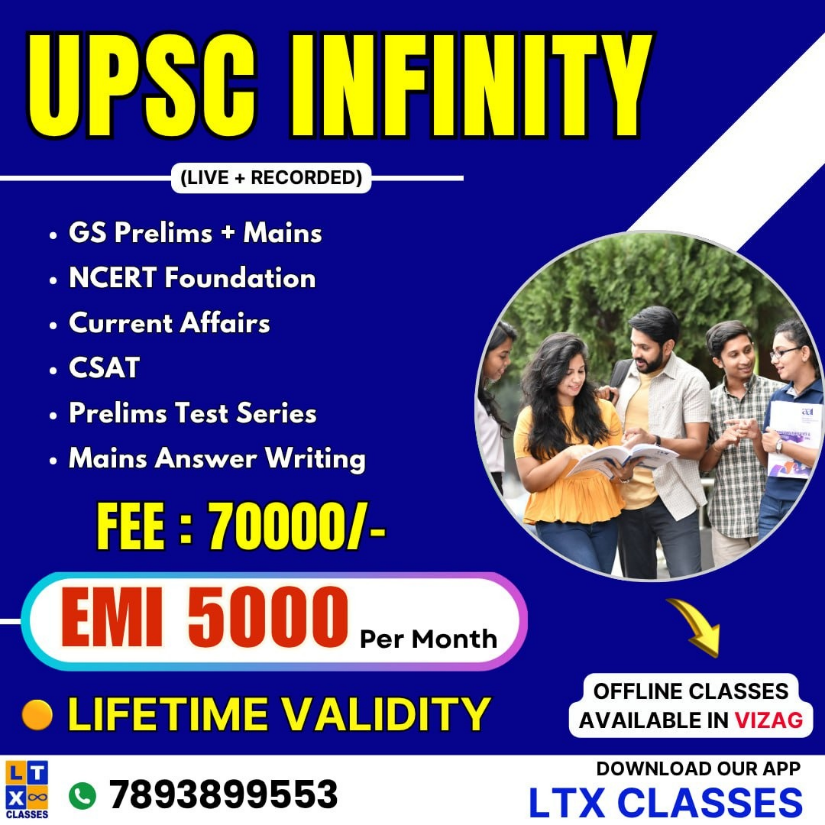

| Index |
| S.No | Topic | Page No |
| Daily Hindu Analysis (YouTube) |
| 1. | A Reading of a Revisionism in Constitutional History |
|
| 2. | Ensure Safeguards for India’s Carbon Market |
|
| 3. | FSSAI Says Only WHO-Approved Products Can Be Labelled as ORS |
|
| 4. | NAM Should Advance Goals of Global South: Kirti Vardhan Singh |
|
| 5. | Arunachal Indigenous Faith Group Pushes for Implementation of Act to ‘Arrest Conversions |
|
| 6. | Three Arrested under Operation Chakra-V |
|
| Daily Current Affairs (App) |
| 7. | Delhi High Court Seeks Centre’s Response on Vacancies in National Commission for Minorities (NCM) |
|
| 8. | SC allows use of NEERI-approved green crackers in Delhi-NCR this Diwali |
|
| 9. | India’s First Genetic Census Reveals Decline in Wild Elephant Population |
|
| 10. | NITI Aayog launches ‘AI for Inclusive Societal Development’ Roadmap |
|
A Reading of a Revisionism in Constitutional History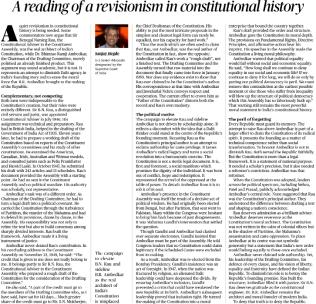
Syllabus Mapping
- GS Paper 2 – Polity and Governance: Historical underpinnings of the Indian Constitution, Role of the Constituent Assembly, Significant features and philosophy of the Constitution, Contributions of B.R. Ambedkar
- GS Paper 1 – Modern Indian History: Social reform movements and Dalit assertion in the national movement.
Context A new debate has emerged in India’s constitutional discourse suggesting that Sir Benegal Narsing Rau, the Constitutional Adviser to the Constituent Assembly, was the true architect of India’s Constitution, while Dr. B.R. Ambedkar merely refined and polished his draft. This argument has sparked controversy, as it is seen as an attempt to dilute Ambedkar’s legacy and the Dalit agency in shaping modern India’s constitutional identity.
What is it All About
The article critically examines this revisionist narrative, emphasizing that while both B.N. Rau and B.R. Ambedkar played indispensable roles, their contributions were complementary, not competing.
- B.N. Rau’s Role:
- A distinguished civil servant and jurist, Rau was appointed Constitutional Adviser in 1946.
- His draft was a technical and preparatory document, based on comparative studies of constitutions across the world (American, Irish, Canadian, and others).
- Rau’s “rough draft” contained 243 articles and 13 schedules, which served as a foundational document for the Constituent Assembly’s deliberations.
- His authority was scholarly, not representative.
- B.R. Ambedkar’s Role:
- As Chairman of the Drafting Committee, Ambedkar transformed the legal draft into a living moral and political document, reflecting the ideals of justice, equality, and liberty.
- He navigated ideological conflicts, mediated between groups, and ensured consensus during the tumultuous years of Partition.
- Ambedkar infused the Constitution with social philosophy, embedding Directive Principles, Fundamental Rights, and affirmative action — making it a progressive and inclusive charter.
Detailed Analysis 1. The Political Motive Behind the Revision
- The attempt to elevate Rau over Ambedkar is not purely academic; it carries a political motive aimed at de-centering Dalit representation in India’s constitutional imagination.
- Such revisionism reflects an effort to redefine the Republic’s founding moral vision, replacing its emancipatory ideals with a bureaucratic or technocratic interpretation.
- Ambedkar’s radical engagement turned the Constitution from a legal document into a social revolution — a promise of equality to the oppressed.
2. Ambedkar’s Radical Vision - Ambedkar saw the Constitution as a means of emancipation for the marginalized and as a framework for transformative politics.
- He envisioned constitutional morality as the cornerstone of India’s democracy — where political equality must translate into social and economic equality.
- His leadership in the Drafting Committee was not about drafting legal language but about infusing justice with humanity.
3. Rau’s Scholarly but Limited Contribution - Rau’s draft was a necessary legal blueprint, but he neither participated in the Assembly’s debates nor shaped the final vision.
- Ambedkar and the Drafting Committee reworked large sections, embedding Indian socio-political realities into the text.
- The attempt to call Rau the “Father of the Constitution” distorts both his humility and the collective nature of the Assembly’s effort.
4. Broader Implications - Historical revisionism of this kind risks rewriting the inclusive and democratic narrative of India’s founding.
- It undermines Ambedkar’s contribution as a Dalit leader and modern constitutionalist, whose ideas on constitutional morality, liberty, and equality remain foundational to Indian democracy.
- The Constitution is not just a legal text; it is the embodiment of social transformation — an aspiration to end caste-based hierarchies and ensure justice for all.
UPSC Mains Q. “Dr. B.R. Ambedkar transformed the Indian Constitution from a legal document into an instrument of social revolution.” Discuss in the context of recent debates on constitutional authorship.
Ensure Safeguards for India’s Carbon Market
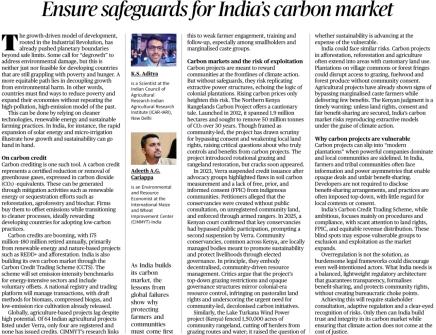
Syllabus Mapping
- GS Paper 3 – Environment: Conservation, Environmental Pollution and Degradation, Environmental Impact Assessment, Climate Change mitigation mechanisms and carbon trading.
- GS Paper 2 – Governance: Policy implementation, participatory governance, rights of vulnerable sections.
Context As India builds its national carbon market, experts have cautioned against replicating exploitative models observed globally. Without adequate safeguards for farmers, tribals, and marginalised communities, carbon projects risk turning into extractive systems that deepen inequality rather than promoting sustainability. The need of the hour is a balanced, transparent, and equitable carbon governance framework that aligns environmental goals with social justice.
What is it All About ·
India’s carbon credit system aims to create financial incentives for industries and projects that reduce or remove greenhouse gas emissions. · A carbon credit represents a certified reduction or removal of one tonne of CO₂-equivalent, generated through activities like reforestation, renewable energy, or sustainable agriculture. · Under the Carbon Credit Trading Scheme (CCTS), India plans to set emission benchmarks and create a national trading platform for credits generated through energy efficiency, afforestation, and cleaner technologies. · However, global experience—especially from Africa—shows that such markets can replicate colonial patterns of land use and disempower local communities, unless robust safeguards are ensured.
Detailed Analysis 1. Lessons from Global Experience
- The Northern Kenya Rangelands Carbon Project, launched in 2012, became one of the world’s largest carbon offset programs but faced scrutiny for bypassing local consent and diverting benefits from communities to project developers.
- In 2023, the Verra carbon certification body suspended credits from this project over lack of Free, Prior and Informed Consent (FPIC).
- Such models reflect a top-down, extractive approach, where carbon revenues accrue to elites rather than those directly managing land and forests.
2. Relevance for India - India’s carbon initiatives—especially in afforestation, renewable energy, and agroforestry—may face similar challenges.
- Projects on village commons, grazing lands, or tribal forests risk displacing local users if implemented without community participation.
- Agricultural carbon projects could exclude smallholders and marginalised farmers, despite their critical role in sustainable land management.
3. Vulnerabilities in India’s Carbon Market Design - Developers and corporations might dominate the carbon market, marginalising local stakeholders.
- Current frameworks focus on procedures and compliance, not equity and benefit-sharing.
- Without legal recognition of community rights, carbon income could bypass those who manage resources on the ground.
- The Carbon Credit Trading Scheme, while ambitious, needs clear guidelines for transparency, consent, and fair benefit distribution.
4. Need for Safeguards and Governance Reforms To prevent carbon markets from becoming exploitative:
- Ensure legal protection of community land and resource rights.
- Mandate FPIC (Free, Prior and Informed Consent) for all carbon projects.
- Guarantee equitable benefit-sharing among local stakeholders.
- Develop an adaptive regulatory system that values social inclusion alongside environmental performance.
- Institutionalise community-led monitoring and grievance redressal mechanisms.
UPSC Mains Q. “While carbon markets promise economic and environmental benefits, they risk deepening social inequalities if not properly regulated.” Examine this statement in the context of India’s emerging carbon credit framework.
FSSAI Says Only WHO-Approved Products Can Be Labelled as ORS
Syllabus Mapping: - GS Paper 2 – Governance: Government policies and interventions for development in health and nutrition sectors; regulatory bodies and their mandates.
- GS Paper 3 – Science and Technology: Application of science in everyday life; developments in health and biotechnology for human welfare.
Context The Food Safety and Standards Authority of India (FSSAI) has issued a major directive prohibiting the use of the term ‘ORS’ (Oral Rehydration Salts) on any food or beverage products unless they strictly comply with the World Health Organization (WHO) standards for oral rehydration formulations.
What is it All About
- The move follows a long-standing campaign by a Hyderabad-based paediatrician against sugar-rich beverages being falsely marketed as oral rehydration solutions (ORS).
- The FSSAI order withdraws all previous permissions that allowed companies to use the term “ORS” or “Oral Rehydration Salts” in brand names.
- It explicitly states that using “ORS” on labels of fruit-based, non-carbonated, or ready-to-drink beverages violates the Food Safety and Standards Act, 2006.
- The regulator emphasized that such mislabelling misleads consumers through false, ambiguous, or deceptive claims about the product’s medical efficacy.
Significance - Ensures consumer protection and public health safety by preventing misleading marketing practices.
- Reinforces that only scientifically approved formulations, consistent with WHO recommendations, can be sold as ORS.
- Upholds the integrity of medical terminology and strengthens regulatory oversight under the Food Safety and Standards Act, 2006.
About FSSAI (Food Safety and Standards Authority of India) - Established: 2008 under the Food Safety and Standards Act, 2006
- Nodal Ministry: Ministry of Health and Family Welfare
- Headquarters: New Delhi
Key Functions: 1. Regulation & Oversight: o Sets science-based standards for food safety and hygiene. o Regulates manufacture, storage, distribution, sale, and import of food.
2. Consumer Protection: o Ensures that food products are safe and free from adulteration or misbranding.
3. Coordination: o Works with state food authorities to enforce food safety laws across India.
4. Awareness & Certification: o Runs initiatives like Eat Right India, Food Fortification, and Clean Street Food Hubs to promote healthy eating.
Motto: “Ensuring safe and wholesome food for all.” |
UPSC Prelims Q: According to the recent FSSAI directive, the term “ORS” (Oral Rehydration Salts) can be used on food or drink products only if:
(a) The product contains added vitamins and minerals.
(b) The formulation adheres to WHO-recommended standards.
(c) It is labelled as sugar-free and low-sodium.
(d) It is registered as a pharmaceutical product. Answer: (b)
NAM Should Advance Goals of Global South: Kirti Vardhan Singh
Syllabus Mapping:
- GS Paper 2 – International Relations: India and its neighbourhood; role of international organizations; India’s foreign policy and its role in the Global South.
- GS Paper 1 – World History: Post-World War II realignments, decolonization, and emergence of the Non-Aligned Movement.
Context At the 19th Mid-Term Ministerial Meeting of the Non-Aligned Movement (NAM) held in Kampala, Uganda, India urged NAM member states to re-purpose the movement to align with the aspirations and priorities of the Global South in a changing geopolitical landscape.
What is it All About
- Minister of State for External Affairs Kirti Vardhan Singh emphasized that NAM must evolve to address contemporary global challenges, especially those affecting developing nations.
- He called on NAM to push for reformed multilateralism, including reforms in the UN Security Council and international financial institutions, so that they reflect 21st-century realities.
- The Minister also highlighted the need to de-stigmatize migration and recognize the movement of skilled professionals as crucial to leveraging the demographic dividend of developing nations.
- On the Israel–Palestine conflict, India reaffirmed its support for a two-state solution, advocating for a sovereign, independent, and viable Palestinian state coexisting peacefully with Israel.
Significance - The statement underlines India’s commitment to revitalizing NAM as a platform to amplify the voice of the Global South.
- It reflects India’s push for a multipolar and equitable world order, where developing nations have greater say in global governance.
- The focus on migration, financial reforms, and peace diplomacy showcases NAM’s potential to become a bridge between the developed and developing world.
UPSC Prelims Q: The Non-Aligned Movement (NAM), recently in news, was originally formed with which of the following objectives?
(a) To promote military cooperation among developing countries
(b) To avoid alignment with any major power bloc during the Cold War
(c) To establish a collective security arrangement under the UN Charter
(d) To promote economic integration among developing nations
Answer: (b)
Arunachal Indigenous Faith Group Pushes for Implementation of Act to ‘Arrest Conversions 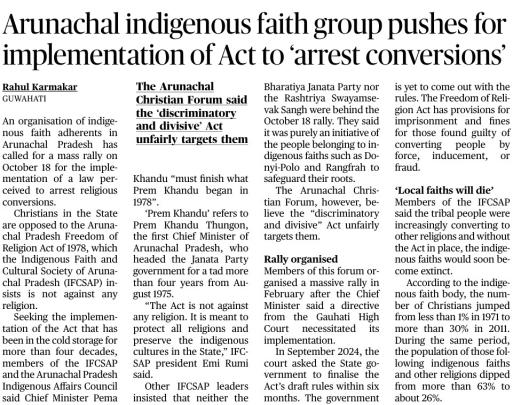
Syllabus Mapping:
- GS Paper 2 – Polity: Fundamental Rights (Article 25 – Freedom of Religion), Relationship between State and Religion, Role of Judiciary.
- GS Paper 1 – Society: Communalism, regionalism, and social empowerment; role of religion in social change and identity.
Context In Arunachal Pradesh, an organisation representing indigenous faith adherents has called for the implementation of the long-pending Arunachal Pradesh Freedom of Religion Act, 1978, which aims to regulate religious conversions in the state. The demand has reignited debates over religious freedom, cultural preservation, and the rights of indigenous communities.
What is it All About - The Indigenous Faith and Cultural Society of Arunachal Pradesh (IFCSAP) has urged the State government to enforce the 1978 Act, which remains unimplemented for over four decades due to the absence of official rules.
- The Act seeks to prevent religious conversions by force, inducement, or fraud, and prescribes imprisonment and fines for violations.
- IFCSAP argues that increasing conversions are leading to a decline in indigenous faiths such as Donyi-Polo and Rangfrah, warning that without implementation, these traditions may face extinction.
- The Arunachal Christian Forum, however, opposes the move, calling the Act “discriminatory and divisive”, claiming it unfairly targets certain communities.
- The State government was directed by the Gauhati High Court (September 2024) to finalise the rules for implementing the Act within six months.
Significance - Reflects the tension between cultural preservation and religious freedom in multi-ethnic societies.
- Brings focus to the constitutional right to freedom of religion (Article 25) and its interaction with state-level anti-conversion laws.
- Raises broader questions about identity, tribal rights, and secular governance in India’s Northeast.
UPSC Prelims Q: The Arunachal Pradesh Freedom of Religion Act, 1978, recently in news, primarily seeks to:
(a) Regulate religious practices among tribal groups
(b) Prevent religious conversions by force, inducement, or fraud
(c) Promote state-sponsored religious institutions
(d) Preserve Buddhist monasteries and tribal cultural sites
Answer: (b)
Three Arrested under Operation Chakra-V
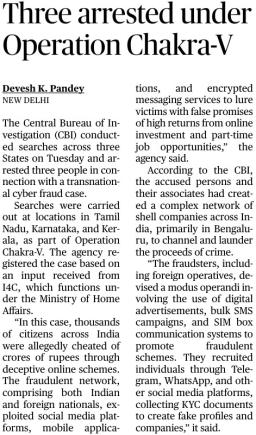
Syllabus Mapping
- GS Paper 3 – Internal Security: Cyber security and money laundering, Challenges to internal security through communication networks, Role of CBI, I4C, and other agencies in countering organized cybercrime
Context The Central Bureau of Investigation (CBI) has arrested three individuals from Tamil Nadu, Karnataka, and Kerala in connection with a transnational cyber fraud under Operation Chakra-V. The operation targets international cybercrime networks defrauding Indian citizens through deceptive online schemes.
What is it All About
- Operation Chakra-V is a coordinated initiative led by the CBI in collaboration with Interpol, FBI, and national cyber agencies like the Indian Cyber Crime Coordination Centre (I4C) under the Ministry of Home Affairs.
- The operation aims to dismantle cyber fraud networks, track financial flows, and identify foreign operatives involved in digital crimes.
In this specific case: - Fraudsters created a network of shell companies, particularly in Bengaluru, to launder money obtained from victims.
- Victims were lured through fake online investment schemes, part-time job offers, and high-return promises promoted via Telegram, WhatsApp, and social media ads.
- The accused used SIM-box systems, bulk SMS campaigns, and encrypted messaging services to operate anonymously and evade detection.
- Collected KYC documents were misused to create fake companies and financial accounts for laundering the proceeds of crime.
Significance - Highlights the growing threat of transnational cybercrime networks exploiting digital platforms and cross-border financial systems.
- Reinforces the need for international cooperation, digital literacy, and robust cyber laws.
- Strengthens India’s ongoing efforts under Digital India and National Cyber Crime Reporting Portal to enhance cybersecurity governance.
UPSC Prelims Q. Operation Chakra-V, recently in news, is related to which of the following?
(a) Strengthening rural digital infrastructure
(b) Combating international cybercrime networks
(c) Promoting digital payment literacy
(d) Ensuring cybersecurity in defence installations
Answer: (b)
Delhi High Court Seeks Centre’s Response on Vacancies in National Commission for Minorities (NCM)
Syllabus: GS Paper 2 – Polity and Governance (Statutory Bodies, Welfare of Minorities)
Context: The Delhi High Court has asked the Union Government to respond regarding the long-pending vacancies in the National Commission for Minorities (NCM). The absence of a full-strength body has raised concerns about the Commission’s effectiveness in protecting minority rights.
Key Points:
- Genesis: Established in 1978 as the Minorities Commission under the Ministry of Home Affairs, later shifted to the Ministry of Welfare (1984).
- Statutory Status: Became a statutory body under the National Commission for Minorities Act, 1992; first statutory Commission formed on 17 May 1993.
- Jurisdiction Change: In 1988, linguistic minorities were excluded from its purview.
- Objective: To safeguard and protect the interests of minority communities in India.
- Composition: Includes a Chairperson, Vice-Chairperson, and five Members, all nominated by the Central Government.
- Eligibility: Members must belong to one of the six notified minority communities — Muslim, Christian, Sikh, Buddhist, Parsi, and Jain.
- Tenure: Each member serves a three-year term from the date of appointment.
- Powers: The NCM exercises quasi-judicial powers to inquire into complaints of minority rights violations.
- Removal Grounds: Members can be removed for insolvency, incapacity, misconduct, or conviction for moral turpitude.
- Current Issue: Vacancies and delays in appointments have led to institutional inefficiency and limited oversight.
About Minorities in India: - Constitutional Context: The Constitution does not define “minority”, but recognises religious and linguistic minorities.
- Statutory Definition: The NCM Act, 1992 defines a minority as a community notified as such by the Central Government.
- Notified Communities:
- Initially (1993): Muslims, Christians, Sikhs, Buddhists, Parsis (Zoroastrians).
- Later (2014): Jains were also added to the list.
Source: The Hindu
SC allows use of NEERI-approved green crackers in Delhi-NCR this Diwali
Syllabus: GS Paper 3 – Environment (Pollution Control & Regulatory Measures) Context: The Supreme Court has permitted limited use of green crackers certified by NEERI in the Delhi-NCR region for Diwali celebrations, aiming to balance festivity and air quality concerns.
Key Points:
- Certification source: Only green crackers approved by NEERI will be allowed.
- Limited usage: The permission is restricted in time, quantity and area to minimise pollution.
- Rationale: To reduce air pollution spikes during Diwali while allowing cultural practices.
- Monitoring & enforcement: Authorities to ensure compliance and penalise violations.
- NEERI’s role: Act as the certifying agency for lower-emission crackers.
- Background of NEERI: Known for research in environmental science, pollution control, sustainable development.
- Institutional setup: NEERI is a CSIR constituent laboratory under Ministry of Science & Technology.
- History: Started as CPHERI in 1958 in Nagpur; renamed NEERI in 1974.
- Locations: Headquarters at Nagpur; zonal labs in Chennai, Delhi, Hyderabad, Kolkata, Mumbai.
- Stakeholder relevance: Offers a scientific and regulatory bridge between public demand and environmental protection.
Source: The Hindu
India’s First Genetic Census Reveals Decline in Wild Elephant Population
Syllabus: GS Paper 3 – Environment and Ecology (Biodiversity Conservation, Wildlife Census and Genetic Studies)
Context: The All-India Synchronous Elephant Estimation (SAIEE) 2025 has revealed India’s wild elephant population at 22,446, marking a 17% decline from the 2017 estimate of 27,312. However, experts caution that the two cannot be directly compared since the 2025 count used a new DNA-based genetic methodology instead of visual sightings.
Key Points:
- First Genetic Census: India conducted its first-ever DNA-based census for elephants, replacing traditional visual counts.
- Sample Collection: Over 21,000 dung samples were collected across 670,000 km of forest trails in elephant habitats.
- Method Used: Scientists applied DNA fingerprinting and mark–recapture modelling to avoid duplication and improve accuracy.
- Enhanced Accuracy: The method provides precise population estimates, similar to techniques used for tiger censuses.
- Regional Distribution:
- Western Ghats: 11,934 elephants (largest stronghold)
- Northeast & Brahmaputra floodplains: 6,559
- Shivalik & Gangetic plains: 2,062
- Central India & Eastern Ghats: 1,891
- Major States:
- Karnataka: 6,013
- Assam: 4,159
- Tamil Nadu: 3,136
- Kerala: 2,785
- Uttarakhand: 1,792
- Odisha: 912
- Smaller Populations: Found in Arunachal Pradesh, Meghalaya, Nagaland, Tripura, Madhya Pradesh, and Maharashtra.
- Major Threats:
- Habitat loss from deforestation and infrastructure projects.
- Blocked migration corridors, forcing elephants into human areas.
- Human–elephant conflicts leading to electrocutions, train accidents, and retaliatory killings.
- Conservation Imperatives: Focus on habitat connectivity, conflict mitigation, and corridor protection.
- Significance: The genetic census ensures reliable data, aids in monitoring genetic diversity, and strengthens future wildlife management strategies.
Source: The Hindu
NITI Aayog launches ‘AI for Inclusive Societal Development’
Roadmap
Syllabus: GS Paper 3 – Science and Technology (Artificial Intelligence, Digital Inclusion, and Employment)
Context: NITI Aayog has released a pioneering national roadmap titled “AI for Inclusive Societal Development”, focusing on using artificial intelligence (AI) and frontier technologies to empower India’s 490 million informal workers. The initiative shifts attention from global AI priorities in white-collar sectors to India’s vast informal economy.
Key Points:
- Objective: To leverage AI for social and economic empowerment of informal workers contributing nearly 50% of India’s GDP.
- Government Backing: Launched with strong inter-ministerial coordination and partnerships involving industry and development agencies.
- Target Groups: Focus on farmers, artisans, gig workers, construction labourers, and healthcare aides.
- Core Issues Addressed: Tackles financial insecurity, limited market access, and skill deficiencies within the informal sector.
- Accessibility Goal: Seeks to make AI tools accessible, affordable, and locally adaptable for grassroots use.
- Mission Digital ShramSetu:
- Serves as the central pillar of the roadmap.
- Uses AI, blockchain, and immersive learning to connect informal workers to digital ecosystems.
- Aims to improve skills, social protection coverage, and livelihood opportunities.
- Outcome Vision: Establish a sustainable, tech-enabled ecosystem where informal workers actively participate in India’s digital economy.
- Broader Impact: Supports India’s goal of inclusive digital transformation under the Digital India and Viksit Bharat 2047 frameworks.
Source: The Hindu








